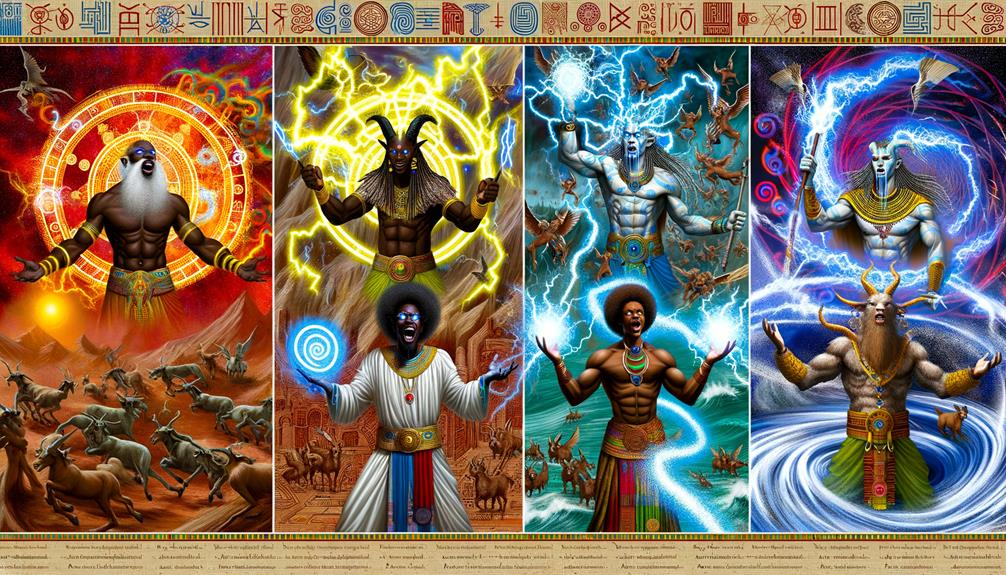Ever pondered the mystery that surrounds Set, the ancient Egyptian god often linked to chaos, disorder, and the unpredictable elements of desert storms and warfare? This deity, who was both worshipped and dreaded, presents a fascinating duality in his mythic role, alternating between a necessary disruptor and a terrifying embodiment of chaos. It's fascinating to consider how his multifaceted character played into the wider fabric of ancient Egyptian religious and cultural practices. As we delve further into the nuanced history of this mysterious god, we begin to understand the ever-changing views of Set, and through this, we might gain a better understanding of the intricate balance of chaos and order in ancient Egyptian beliefs.
Origins of Set's Name
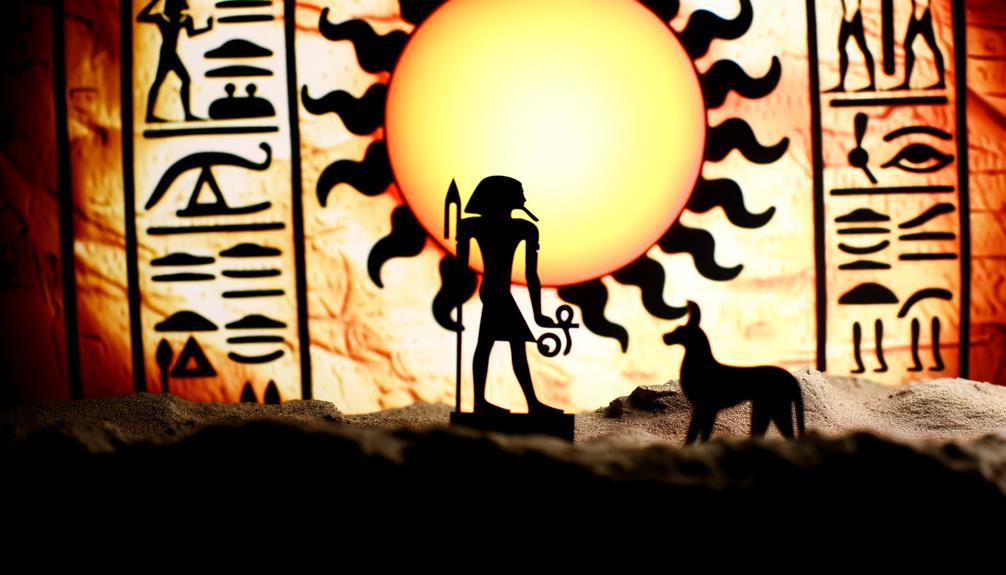
Set's name, depicted in ancient Egyptian hieroglyphs as sṯ or swth, has a meaning that's still a bit of a puzzle. It's fascinating to think it might mean 'he who is below'. This idea would be a perfect fit with Set's role of chaos and his rivalry with Horus, often referred to as 'the one who is above'.
This idea of Set gels well with the picture the ancient Egyptians painted of him. You could say Set was the bad boy of the Egyptian pantheon, a god of chaos and the desert. He was always stirring up trouble and messing with the balance. His ongoing feud with Horus, the sky god and symbol of order, is a clear example of this. You can see the stark difference between these two not just in their roles, but possibly in their names as well.
The mystery of Set's name adds an extra layer of intrigue to Egyptian mythology. It shows how the ancient Egyptians put a lot of thought into their pantheon, crafting detailed relationships between their gods. Opinions from Egyptologists about Set's name and its potential meanings add more depth and richness to the tapestry of Egyptian myth.
Role in Egyptian Mythology
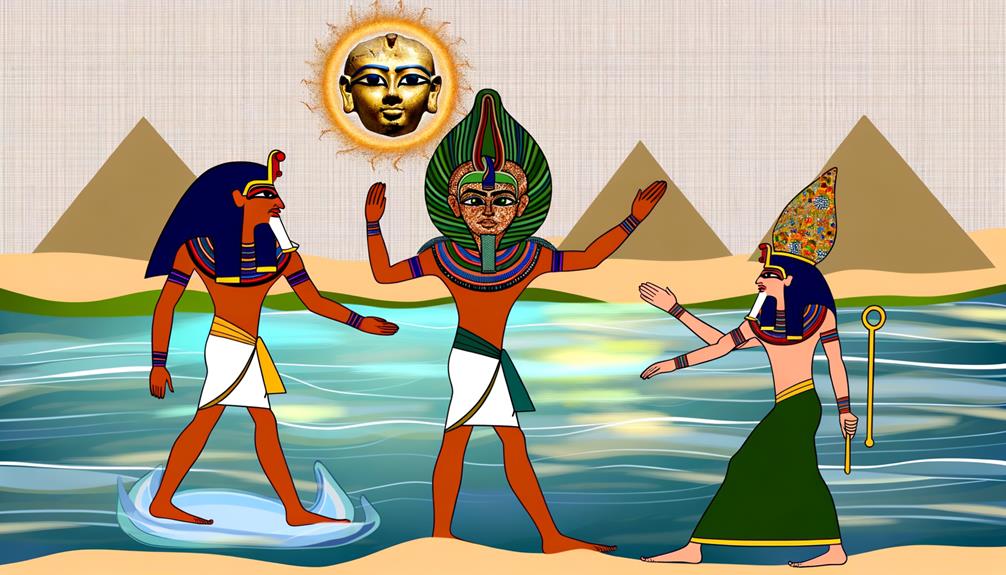
Let's dive into the world of Egyptian mythology, where Seth, a god with a canine body and a long, curved snout, takes centre stage. Seth is a bit of a jumble – he embodies chaos, violence, and the severity of desert landscapes, yet he's also a protector of the divine order, a bit like a cosmic prankster.
His role in the myths of ancient Egypt is layered. He's Osiris's brother and Horus's uncle, and his deeds sparked a dramatic power struggle with Horus over their father's throne. This family feud is one of the most famous tales from ancient Egypt. It's a story where Seth not only kills Osiris but also fights with Horus, symbolizing the timeless clash between order and chaos.
Seth also had a key role in the Sun God's nightly travels through the underworld, where he defended the sun barque from the terrifying serpent Apep. So, even though Seth was the embodiment of chaos, he was also seen as a guardian, making him an important character in the Egyptian faith.
Over the centuries, Seth's reputation took a bit of a hit, getting tied up with evil and foreign invaders. Despite this, his reputation as the God of Chaos lived on, leaving a mark on other cultures and religions and showing the enduring, multifaceted role he played in the mythology of ancient Egypt.
Set's Interaction With Other Gods
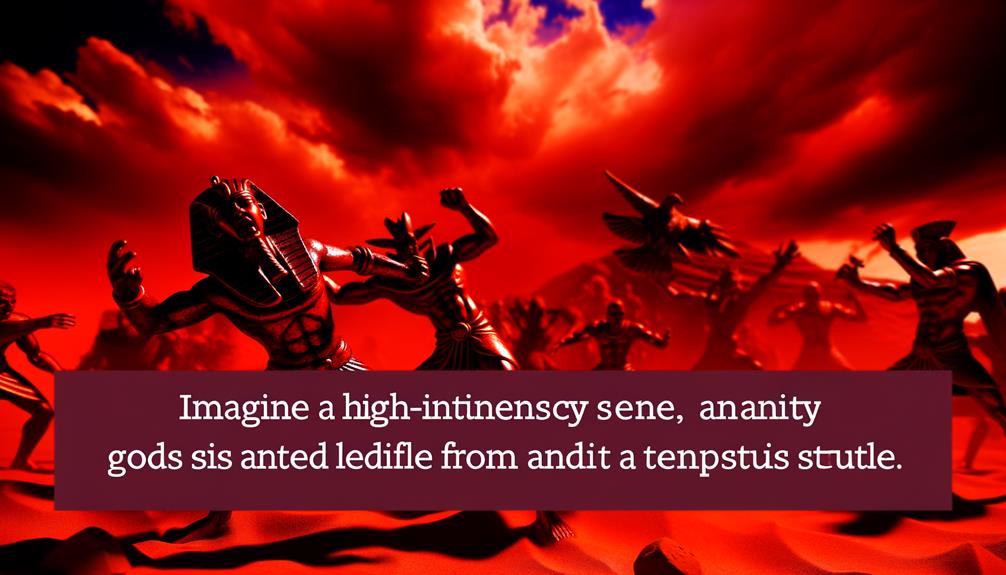
When you dig into the myths about Set, an Egyptian god, you'll find a lot of drama. His relationships with the other gods, like his brother Osiris and nephew Horus, were often filled with conflict and power plays. Set, the god of the earth, was a symbol of chaos and disruption. He was notorious for causing trouble among the gods who represented order and stability, such as Osiris, the god of the dead, and Horus, the god of the sky.
The rivalry between Set and these Egyptian gods is most clearly shown in the story where he kills Osiris and goes to war with Horus. This ongoing cycle of violence and revenge paints a picture of Set's story as a never-ending battle for control, showing the stormy relationship between these gods and goddesses.
But Set's dealings with the other gods weren't always hostile. There were times when he teamed up with other gods to fend off threats to the cosmic order. This two-sided nature highlights Set's complex position in the pantheon, where he represents both destruction and protection at the same time. So, the way Set interacted with the other gods really shows the detailed and many-sided character of Egyptian mythology.
Iconic Symbols of Set
Set, an intriguing deity from ancient Egypt, has a rich backstory filled with volatile interactions with other gods. But, to truly appreciate Set, we need to look at the symbols that define him, the most notable being the mysterious Set animal. This creature, hailing from Upper Egypt, is a physical representation of Set's ties to chaos and violence.
Let's take a look at what makes the Set animal unique:
- Its snout is long and curved
- Its ears are square-shaped
- It has a body similar to a dog
In ancient times, during the Middle Kingdom era, people used the Set animal as a charm to keep away evil. By the New Kingdom period, the symbolism of the Set animal began to reflect Set's evolving role among the gods. It's quite interesting to see how the image of the Set animal changed over the long stretch of ancient Egyptian history, spanning 38 centuries.
But Set's representation doesn't stop at the Set animal. He's also closely linked to other gods, such as:
- The Nile god, who represents Set's power over the Nile's more destructive elements
- The Thunder god, who emphasizes Set's connection to tumultuous storms and chaos
The Ambivalence of Set's Character
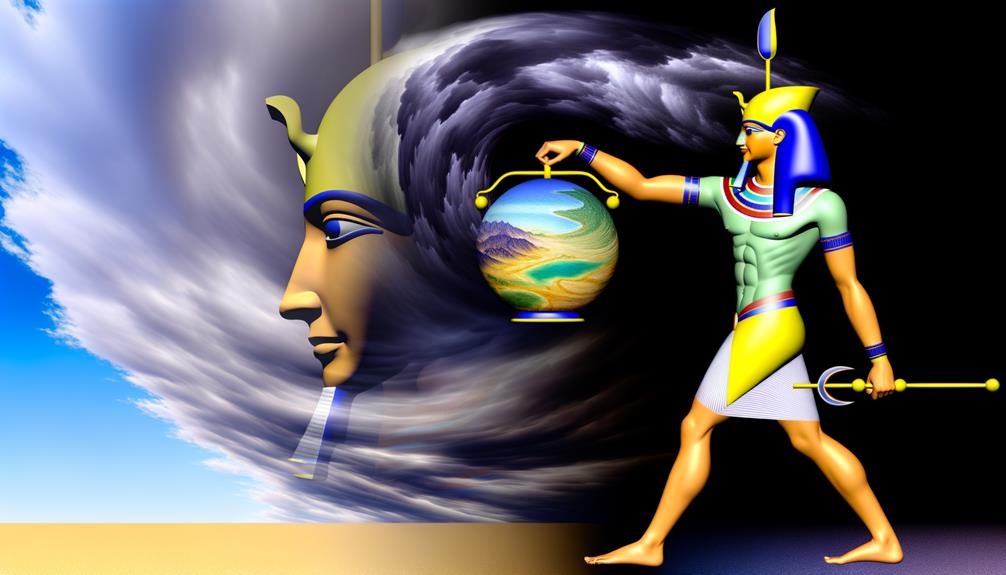
Let's chat about Set, a character who embodies a captivating blend of chaos and order, capturing the Egyptians' mixed feelings towards him. Set was perceived differently in the early Egyptian era; he was seen as a guardian of soldiers, hunters, and traders. Yet, he also stirred up trouble among those who opposed Egypt. His dual persona of a protector and instigator is quite intriguing.
The plot thickens during the Intermediate Period. Consumed by envy, Set kills Osiris, his brother, to seize the throne. That's when his association with foreign lands and the Underworld comes into play, adding a sense of chaos to the structured world.
Here are some interesting facts about Set:
| Aspect | Description |
|---|---|
| Divine Relations | He is the son of the sky goddess, and a brother to Osiris, Isis, and Nephthys |
| Parents | His parents are Shu and Tefnut, who are the gods of air and moisture |
| Role | He serves as a protector and a bringer of chaos |
| Symbol | His symbols include the Was scepter and the Set animal |
Set's ongoing struggle between good and evil mirrors the destructive and nurturing cycles of the Nile River. His contradictory personality reflects the Egyptians' own conflicted feelings towards chaos and order. This ambiguity mirrors the intricacies of life and the constant tug-of-war between creation and destruction.
Frequently Asked Questions
What Is the Origin of the Set God?
Did you ever wonder where the concept of the god Set originated from? Well, let's turn back the pages of history to ancient Egypt. That's where you'll find the first signs of Set being recognized as a divine entity. Upper Egypt's Nubt was his initial place of worship. Set was attributed with quite a few roles – he was seen as a deity of the sky, the ruler of the desert, and the controller of storms and warfare. Quite an impressive resume, wouldn't you agree?
Why Was Seth the God of Chaos?
You know, Seth was often seen as the God of Chaos, but why was that? Well, it's largely due to his ties to violence and mayhem. Think about his unpredictable behaviour, such as when he killed Osiris. It's actions like these that really emphasized his role as a disruptor in Egyptian mythology. He wasn't causing chaos just for the sake of it, though. It was necessary chaos, important for the mythological narrative.
What Is the Story of Seth in the Myth?
In the tale, Seth is infamous for his intense competition with his brother, Osiris, and his nephew, Horus. The story takes a dark turn when Seth takes Osiris' life, sparking a struggle against Horus for the reins of Egypt. In this conflict, Seth becomes a symbol of chaos and brutality, standing in stark opposition to Horus, who represents law and justice.
Why Did Set Turn Evil?
You might be wondering, why did Set become such a villain? Well, it's a bit of a tale. You see, Set was overcome by a dangerous mix of envy and desire for power. Being a god, he had responsibilities that made him feel entitled, and this sense of entitlement twisted his understanding of power.
But it wasn't just that. His relevance began to fade, and his connections to foreign territories grew stronger. These changes just added fuel to his growing malevolence. So, in short, his journey to the dark side was set in motion by a combination of factors, each playing its part in shaping him into the villain we know today.

